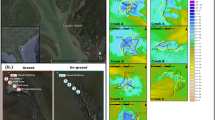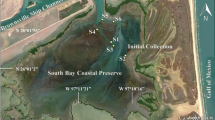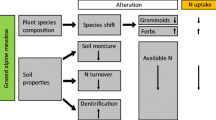Abstract
Dying leaves ofSpartina alterniflora Loisel (hereafterSpartina) do not undergo abscission and consequently are at least partially degraded while remaining attached to the shoot, i.e., under conditions which may be very different from those occurring in litterbags used to measure decomposition ofSpartina at the sediment surface. Attached living and dead leaves in high-marsh areas are subject to grazing by the abundant gastropodLittorina irrorata Say (hereafterLittorina), a salt marsh periwinkle. In 1986, nitrogen assimilation from living and standing-deadSpartina byLittorina was examined in Sapelo Island (Georgia, USA) salt marshes by labelling plants with the stable nitrogen isotope15N and measuring the transfer into grazing snails in the field. The initial label of ca 8% total plant nitrogen declined to ca 1% over 5 mo, perhaps due to label dilution by less enriched nitrogen taken up and translocated from below- to above-groundSpartina biomass. Snails incorporatedSpartina-derived nitrogen into tissues at rates equal to 10 to 20% of total snail nitrogen 30-d−1 in summer and fall, and 2 to 5% 30-d−1 in winter. In the absence of measurable growth, these high nitrogen incorporation rates may indicate a large reproductive effort, or substantial turnover of somatic tissue nitrogen. The annual total assimilation ofSpartina-derived nitrogen was equal to theLittorina-nitrogen biomass. Assimilation of nitrogen in the presence of livingSpartina material (dead material removed) was reduced substantially below that in the presence of intact plants (living and dead material present).Littorina populations at abundances found in Georgia would assimilate ca 3.4% of above-groundSpartina-nitrogen production annually in high-marsh, short-Spartina areas. Based on preliminary estimates of nitrogen assimilation efficiency, 13.2 to 27.2% of short-Spartina production could be ingested annually by Georgia populations ofLittorina. Most of this ingestion would be concentrated in the summer and early fall, when monthly ingestion could equal 100% of deadSpartina biomass. The impact of grazing byLittorina onSpartina decomposition may be greatest on these early-senescing leaves. Grazing may have little impact on the early stages of decomposition of the bulk of the shoots that senesce later in fall, but may be important in the later stages of decomposition of dead shoots that persist through winter until the following spring and summer.
Similar content being viewed by others
Literature cited
Alexander, S. K. (1976). Relationship of macrophyte detritus to the salt marsh periwinkle,Littorina irrorata Say. Ph.D. Thesis, Louisiana State University, Baton rouge
Alexander, S. K. (1979). Diet of the periwinkleLittorina irrorata in a Louisiana salt marsh. Gulf Res. Rep. 6: 293–295
Anderson, C. E. (1974). A review of structure in several North Carolina salt marsh plants. In: Reimold, R. J., Queen, W. H. (eds.) Ecology of halophytes. Academic Press, N.Y., p. 307–344
Baxter, D. A. (1983). The influence of habitat heterogeneity on the population ecology ofLittorina irrorata (Say), the salt marsh periwinkle. Ph.D. Dissertation, Duke University, North Carolina
Bingham, F. O. (1972). The influence of environmental stimuli on the direction of movement of the supralittoral gastropodLittorina irrorata. Bull. mar. Sci. 22: 309–335
Cammen, L. M., Seneca, E. D., Stroud, L. M. (1980). Energy flow through the fiddler crabsUca pugnax andU. minax and the marsh periwinkleLittorina irrorata in a North Carolina salt marsh. Am. Midl. Nat. 103: 238–250
Chalmers, A. G. (1979). The effects of fertilization on nitrogen distribution in aSpartina alterniflora salt marsh. Estuar. cstl mar. Sci. 8: 327–337
Connor, V. M., Quinn, J. F. (1984). Stimulation of food species growth by limpet mucus. Science, N.Y. 225: 843–844
Crist, R. W., Banta, W. C. (1983). Distribution of the marsh periwinkleLittorina irrorata (Say) in a Virginia salt marsh. Gulf Res. Rep. 7: 225–235
Dame, R. F., Kenny, P. D. (1986). Variability ofSpartina alterniflora primary production in the euhaline North Inlet estuary. Mar. Ecol. Prog. Ser. 32: 71–80
Fallon, R. D., Newell, S. Y., Groene, L. C. (1985). Phylloplane algae of standing deadSpartina alterniflora. Mar. Biol 90: 121–127
Fiedler, R., Proksch, G. (1975). The determination of N-15 by emission and mass spectrometry in biochemical analysis: a review. Analytica. chim. Acta 78: 1–62
Hall, J. R. (1973). Intraspecific trail-following in the marsh periwinkleLittorina irrorata Say. Veliger 16: 72–75
Hamilton, P. V. (1977a). Daily movements and visual location of plant stems byLittorina irrorata (Mollusca: Gastropoda). Mar. behav. Physiol. 4: 293–304
Hamilton, P. V. (1977b). The use of mucous trails in gastropod orientation studies. Malac. Rev. 10: 73–76
Hopkinson, C., Kipp, S., Stevenson, J. (1988). Nitrogen pools and turnover times in a tropical seagrass meadow, Terminos Lagoon. In: Yanez-Arancibia, A., Day, J. (eds.) Ecology of coastal ecosystems in the southern Gulf of Mexico: the Terminos Lagoon region, University Nacional Autonoma de Mexico Press, Ciudad Universitaria, Mexico, p. 171–180
Hopkinson, C., Sherr, B., Ducklow, H. (1987). Microbial regeneration of ammonium in the water column of Davies Reef, Australia. Mar. Ecol. Prog. Ser. 41: 147–153
Hopkinson, C. S., Schubauer, J. P. (1984). Static and dynamic aspects of nitrogen cycling in the salt marsh gramminoid,Spartina alterniflora Loisel. Ecology 65: 961–969
Lopez, G. R., Levinton, J. S. (1987). Ecology of deposit-feeding animals in marine sediments. Q. Rev. Biol. 62: 235–259
Marples, T. G. (1966). A radionuclide study of arthropod food chains in aSpartina salt marsh ecosystem. Ecology 47: 270–277
McBride, C. J., Williams, A. H. (1987). The importance ofSpartina alterniflora toLittorina irrorata's growth and mortality. Benthic Ecology Meeting Abstracts, University N. Carolina, Raleigh
McBride, C. J., Williams, A. H., Henry, R. P. (1989). Effects of temperature on climbing behavior ofLittorina irrorata: on avoiding a hot foot. Mar. behav. Physiol. 14: 93–100
McKee, K. L., Seneca, E. D. (1982). The influence of morphology in determining the decomposition of two salt marsh macrophytes. Estuaries 5: 302–309
Newell, S. Y., Fallon, R. D., Miller, J. D. (1989). Decomposition and microbial dynamics for standing, naturally positioned leaves of a salt marsh grassSpartina alterniflora. Mar. Biol. 101: 471–481
Odum, E. P., De la Cruz, A. A. (1967). Particulate organic detritus in a Georgia salt marsh estuarine ecosystem. In: Lauff, G. H. (ed.) Estuaries. Publs Am. Ass. Adunt Sci. (N.Y.) 83: 383–388
Rice, D. L. (1982). The detritus nitrogen problem: new observations and perspectives from organic geochemistry. Mar. Ecol. Prog. Ser. 9: 153–162
Robertson, A. I., Mann, K. H. (1982). Population dynamics and life history adaptations ofLittorina neglecta Bean in an eelgrass meadow (Zostera marine L.) in Nova Scotia. J. exp. mar. Biol. Ecol. 63: 151–171
Schubauer, J. P., Hopkinson, C. S. (1984). Above and belowground emergent macrophyte production and turnover in a coastal marsh ecosystem, Georgia. Limnol. Oceanogr. 29: 1052–1065
Shirley, T. C., Denoux, G. J., Stickle, W. B. (1978). Seasonal respiration in the marsh periwinkle,Littorina irrorata. Biol. Bull. mar. biol. Lab., Woods Hole 154: 322–334
Smalley, A. E. (1958). The role of two invertebrate populations,Littorina irrorata andOrchelimum fificinium, in the energy flow of a salt marsh. Ph.D. Thesis, University Georgia, Athens
Sokal, R. R., Rohlf, F. J. (1981). Biometry. The principles and practise of statistics in biological research. 2nd ed. W. H. Freeman & Co., New York
Stiven, A. E., Hunter, J. T. (1976). Growth and mortality ofLittorina irrorata Say in three North Carolina marshes. Chesapeake Sci. 17: 168–176
Stiven, A. E., Kuenzler, E. J. (1979). The response of two salt marsh molluscs,Littorina irrorata andGeukensia demissa, to field manipulations of density andSpartina litter. Ecol. Monogr. 49: 151–171
Teal, J. M. (1962). Energy flow in the salt marsh ecosystem of Georgia. Ecology 43: 614–624
Tenore, K. R., Cammen, L. M., Findlay, S. E., Phillips, N. W. (1982). Factors regulating availability of detritus to macroconsumers are related to source of detritus. J. mar. Res. 40: 473–490
Tenore, K. R., Rice, D. L. (1980). A review of trophic factors affecting secondary production of deposit-feeders. In: Tenore, K. R., Coull, B. C. (eds.) Marine benthic dynamics. University South Carolina Press, Columbia, p. 325–340
Torzilli, A. P., Andrykovitch, G. (1986). Degradation ofSpartina lignocellulose by individual and mixed cultures of salt-marsh fungi. Can. J. Bot. 64: 2211–2215
Valiela, I., Teal, J. M., Allen, S. D., van Etten, R., Goehringer, D., Volkman, S. (1985). Decomposition in salt marsh ecosystems: the phases and major factors affecting disappearance of above ground organic matter. J. exp. mar. Biol. Ecol. 89: 29–54
Warren, J. H. (1985). Climbing as an avoidance behavior in the salt marsh periwinkle,Littorina irrorata (Say). J. exp. mar. Biol. Ecol. 89: 11–28
Wilson, J. O., Buchsbaum, R., Valiela, I., Swain, T. (1986a). Decomposition in salt marsh ecosystems: phenolic dynamics during decay of litter ofSpartina alterniflora. Mar. Ecol. Prog. Ser. 29: 177–187
Wilson, J. O., Valiela, I., Swain, T. (1986b). Carbohydrate dynamics during decay of litter ofSpartina alterniflora. Mar. Biol. 92: 277–284
Author information
Authors and Affiliations
Additional information
Communicated by J. Grassle, Woods Hole
Rights and permissions
About this article
Cite this article
Kemp, P.F., Newell, S.Y. & Hopkinson, C.S. Importance of grazing on the salt-marsh grassSpartina alterniflora to nitrogen turnover in a macrofaunal consumer,Littorina irrorata, and to decomposition of standing-deadSpartina . Mar. Biol. 104, 311–319 (1990). https://doi.org/10.1007/BF01313273
Accepted:
Issue Date:
DOI: https://doi.org/10.1007/BF01313273




